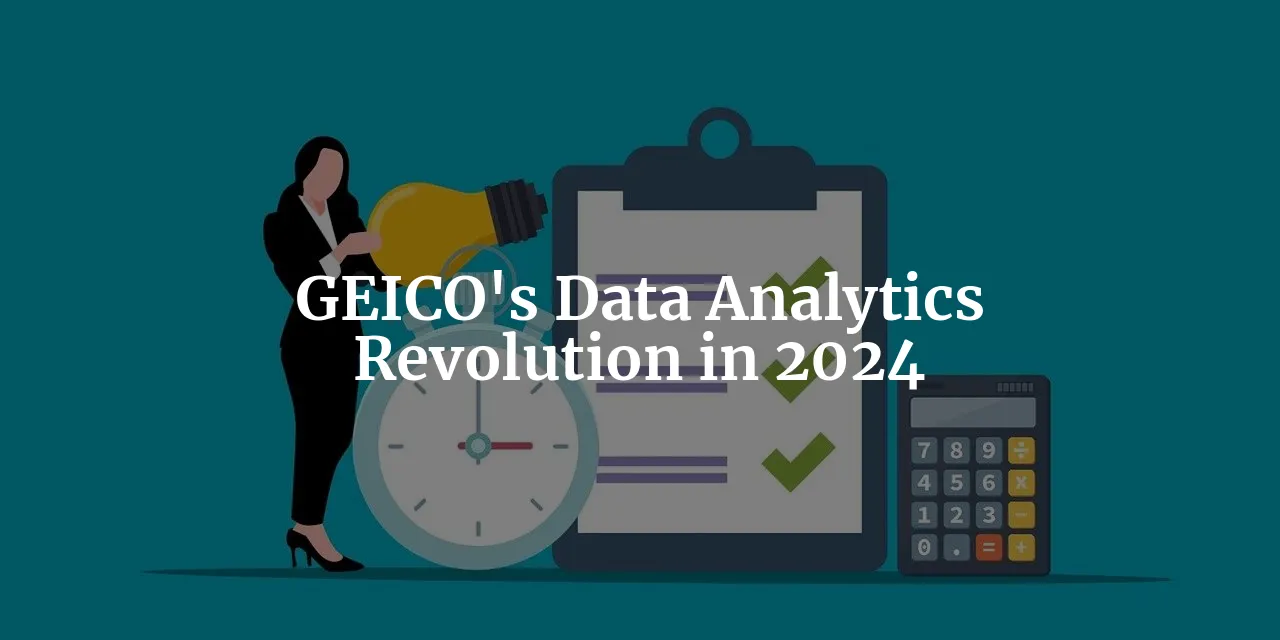Tags: GEICO / Earnings
This fanpage is not officially affiliated with Berkshire Hathaway: Disclaimer
GEICO was one of the bright shining stars of this year's annual shareholder meeting. Discover how GEICO bounced back strong in 2024 with the help of a Data Analytics Revolution, showcasing remarkable growth and improved financial performance.

Introduction
Since its inception in 1936, GEICO has evolved from a niche insurer for government employees to a dominant force in the U.S. auto insurance market, now serving over 15 million policyholders with coverage for more than 24 million motor vehicles 6. Despite its historical achievements and market position, GEICO has faced significant challenges in recent years, particularly in the realm of data analytics and technology adaptation. These challenges were highlighted by Todd Combs, who pointed out the need for a stronger focus on data analytics to enhance operational efficiencies and risk assessment 5.
The first quarter of 2024 marked a turning point for GEICO, showcasing a robust recovery with a remarkable increase in underwriting earnings from $703 million in Q1 2023 to $1.928 billion in Q1 2024 1, 3. This performance not only reflects GEICO's resilience but also its strategic acumen in navigating through its challenges and capitalizing on its strengths.
This article aims to dissect GEICO's Data Analytics Revolution and its pivotal role in the company's strong rebound in 2024. For shareholders of Berkshire Hathaway, understanding GEICO's trajectory and strategic focus is crucial, given its significant contribution to Berkshire's portfolio ↗. We will explore how GEICO is leveraging its historical strengths while addressing past weaknesses, particularly in data analytics, to ensure sustained growth and profitability. The discussion will extend into GEICO's financial performance, strategic partnerships, and future outlook, providing a comprehensive analysis of its journey towards bridging the data analytics gap by the end of 2025.
Historical Context and Recent Challenges
GEICO’s journey began in 1936 when Leo Goodwin Sr. and his wife Lillian decided to start an auto insurance company that catered primarily to federal government employees and military personnel. This focus on a niche market allowed GEICO to grow steadily, becoming a publicly traded company by 1948 and expanding its services to the general public in 1974 under Ralph Peck’s leadership 6. However, the late 1970s brought severe financial distress, with GEICO facing a staggering loss of $126.5 million in 1975, which almost led to its collapse. A consortium of 45 insurance companies intervened, taking over a significant portion of its policies to keep the insurer afloat 6.
The acquisition by Berkshire Hathaway in the mid-1990s marked a new era of stability and growth. Under Berkshire's umbrella, GEICO expanded its market reach and diversified its insurance offerings, becoming the second-largest auto insurer in the United States 6. Despite these successes, GEICO has not been immune to challenges. The rapid evolution of digital technologies and data analytics posed a significant hurdle, as highlighted during Berkshire’s 2024 annual shareholder meeting. Ben Noll, a long-time shareholder, raised concerns about GEICO's lag in adopting advanced data analytics, which is crucial for matching rate with risk and effectively segmenting and pricing products 5.
The recent years have seen GEICO making concerted efforts to overcome these challenges. Todd Combs, who became CEO a decade after initially highlighting the importance of data analytics, has been instrumental in steering GEICO towards a data-driven approach 5. This shift is evident in the company's financial turnaround in the first quarter of 2024, where it not only improved its loss ratios and expense ratios but also significantly boosted its underwriting earnings 1, 3.
The historical context of GEICO’s operations and the recent emphasis on overcoming data analytics challenges set the stage for a detailed exploration of its strategic maneuvers in 2024. The next sections will delve deeper into GEICO's stellar performance this year, its strategic partnerships, efforts in bridging the data analytics gap, and the broader implications for its future trajectory within the competitive insurance landscape.
Stellar Performance in Q1 2024
In the first quarter of 2024, GEICO has demonstrated a remarkable turnaround in its financial performance, setting a new benchmark in the insurance industry ↗. The company's underwriting profits surged dramatically, reaching a pre-tax underwriting earning of $1.928 billion, a significant increase from $703 million in the same quarter of the previous year 123. This 174% growth in earnings is a testament to GEICO's robust strategic initiatives and operational efficiencies 1:
| Q1 2024 | Q1 2023 | |
|---|---|---|
| Premiums written | $10,796 | $10,060 |
| Premiums earned | $10,234 (100.0%) | $9,626 (100.0%) |
| Losses and loss adjustment expenses | $7,414 (72.5%) | $7,992 (83.0%) |
| Underwriting expenses | $892 (8.7%) | $931 (9.7%) |
| Total losses and expenses | $8,306 (81.2%) | $8,923 (92.7%) |
| Pre-tax underwriting earnings | $1,928 🚀 | $703 |
Several factors contributed to this stellar performance. Firstly, GEICO's loss ratio improved substantially, dropping to 72.5% in Q1 2024 from 83.0% in Q1 2023 1. This improvement was driven by a decline in claims frequencies for property damage and collision coverages, despite an increase in average claims severities for property damage, collision, and bodily injury coverages 1. This indicates that while the cost per claim has risen, the overall number of claims has decreased, contributing to better financial health.
Furthermore, GEICO's underwriting expenses saw a decrease of $39 million, or 4.2%, compared to the previous year 1. The company's expense ratio also improved, dropping by 1.0 percentage point to 8.7% 1. These figures highlight GEICO's successful efforts in enhancing operational efficiencies, which have played a crucial role in boosting profitability.
Operational strategies such as leveraging advanced data analytics to improve risk assessment and claims processing, and optimizing resource allocation have been pivotal. Industry experts and analysts have lauded these moves, noting that GEICO's ability to adapt and innovate has set it apart in a competitive landscape.
Strategic Partnerships and Market Positioning
2024 marked a significant year for GEICO in terms of strategic partnerships, particularly with its new collaboration with the NCAA. This partnership, which makes GEICO the official home and auto insurance partner of the NCAA, covers all 90 men's and women's championships 4. The association with such a high-profile organization offers GEICO unparalleled brand visibility and numerous opportunities to engage with a diverse customer base across the United States.
This partnership is strategically important as it places GEICO at the forefront during high-visibility events like the NCAA men's and women's March Madness tournaments. Such platforms not only enhance brand recall but also allow GEICO to showcase its commitment to the community and sports, aligning with its brand values of reliability and support 4.
In the broader market, GEICO maintains its position as the third-largest auto insurer in the U.S. 6. This status is not just a testament to its size but also to its strategic foresight in adopting aggressive marketing and partnership strategies. Iconic advertising campaigns and sponsorships, such as those with NASCAR and now the NCAA, play a crucial role in maintaining GEICO’s strong consumer presence and market dominance 46.
The competitive landscape in the insurance industry demands innovation and adaptability, and GEICO's approach has been exemplary in this regard. By aligning itself with major sports organizations and continuing to invest in high-impact marketing strategies, GEICO not only enhances its brand visibility but also solidifies its market positioning.
Looking ahead, the potential for future partnerships and market expansion, particularly in emerging insurance domains, appears promising. GEICO's track record of strategic collaborations and its robust market presence provide a strong foundation for exploring new avenues and continuing its trajectory of growth and innovation.
Bridging the Data Analytics Gap
In recent years, GEICO has faced scrutiny over its data analytics capabilities, particularly in how these tools are applied to risk assessment and product pricing. Criticisms have been notably vocal from long-standing shareholders like Ben Noll, who questioned Berkshire Hathaway's management strategies at GEICO during the 2024 annual shareholder meeting 5. These concerns highlighted a significant gap between GEICO's operational strategies and the industry's rapid advancement in data analytics.
Let us have a look at what Warren Buffett and Ajit Jain had to comment on the question and what we may learn from it:
The Strategic Shift Under Todd Combs. The turning point for GEICO's data analytics journey began with Todd Combs' leadership. Appointed CEO after a decade of highlighting the importance of data analytics, Combs has been pivotal in steering GEICO towards a data-centric approach. His commitment is not just about catching up with the industry but setting a benchmark for it. By the end of 2025, GEICO aims to fully bridge its analytics gap, enhancing its ability to match rate with risk and segment and price products more accurately based on risk characteristics 5.
Technological Investments. To achieve these ambitious goals, GEICO has ramped up its investment in cutting-edge technologies. This includes deploying advanced machine learning algorithms and big data platforms that can process and analyze vast amounts of data more efficiently. These tools are crucial for improving accuracy in customer segmentation and risk evaluation, directly impacting underwriting profitability.
Impact on Risk Assessment and Pricing Accuracy. With enhanced data analytics, GEICO expects to revolutionize its approach to risk assessment and pricing strategies. The ability to analyze more data points and integrate them into pricing models means that GEICO can offer rates that are more closely aligned with the actual risk posed by individual policyholders. This not only optimizes profitability but also enhances customer satisfaction by offering fair and transparent pricing 5.
Timeline and Steps to Bridge the Gap. GEICO has set a clear timeline to achieve these improvements by the end of 2025. The plan includes several phases, starting with upgrading IT infrastructure, followed by training staff on new analytics tools, and finally integrating these tools into everyday business processes. Each phase is designed to build on the previous one, ensuring a smooth transition and minimal disruption to service.
Understanding Data Analytics in Insurance. Data Analytics involves using statistical tools and algorithms to analyze data to make better business decisions. In the context of insurance, this can mean analyzing past claims data to predict future risks, or using customer behavior data to tailor insurance products to specific market segments.
Competitive Edge and Market Share. The advancements in data analytics are expected not only to enhance GEICO's operational efficiency but also to solidify its competitive edge in the market. By offering more accurately priced products and superior customer service, GEICO is poised to increase its market share and strengthen its position as a leader in the auto insurance industry 5.
By addressing the data analytics gap head-on, GEICO is not just responding to critiques but is proactively shaping its future. The strategic focus on data analytics under Todd Combs' leadership is set to transform GEICO's business model, driving it towards greater efficiency and profitability in the highly competitive insurance landscape.

Conclusion and Future Outlook
GEICO's Data Analytics Revolution in 2024 has been nothing short of remarkable, showcasing a robust recovery and strategic acumen in navigating through challenges. The company's stellar performance, marked by a significant increase in underwriting earnings, improved loss ratios, and strategic partnerships, underscores its resilience and adaptability in a competitive landscape.
GEICO's historical challenges, including financial distress in the past and recent data analytics shortcomings, have been effectively addressed through strategic initiatives under Todd Combs' leadership. The company's focus on bridging the data analytics gap, leveraging advanced technologies, and enhancing risk assessment and pricing accuracy positions it for sustained growth and profitability.
For shareholders of Berkshire Hathaway, GEICO's resurgence in 2024 bodes well for the company's portfolio ↗ ↗. The potential long-term benefits of GEICO's data analytics focus include increased market share, operational efficiency, and competitive edge in the insurance industry. Shareholders can expect continued innovation and adaptation from GEICO, ensuring its status as a leading auto insurer while enhancing technological capabilities.
Looking ahead, GEICO's commitment to maintaining its strategic direction and leadership in data analytics sets a positive outlook for future performance. As the industry evolves rapidly, GEICO's proactive approach to innovation and customer-centric strategies will be key in navigating challenges and seizing opportunities for growth.
GEICO's Data Analytics Revolution in 2024 not only highlights its resilience and strategic acumen but also sets a strong foundation for sustained success in the dynamic insurance landscape. Shareholders can rest assured in GEICO's trajectory towards continued growth and profitability, underpinned by a data-driven approach and commitment to excellence.
References
-
2024 First Quarter Report - www.berkshirehathaway.com ↩↩↩↩↩↩↩↩
-
Berkshire’s UW profits surge to $3.3bn as Geico’s gain more than doubles to $1.9bn | The Insurer - www.theinsurer.com ↩
-
Berkshire Hathaway operating earnings soar 39% as Buffett's cash hoard swells to record $188 billion - www.cnbc.com ↩↩↩
-
NCAA and GEICO Announce New Corporate Partnership - www.geico.com ↩↩↩
-
Transcript: Berkshire’s 2024 annual shareholder meeting - steadycompounding.com ↩↩↩↩↩↩↩












